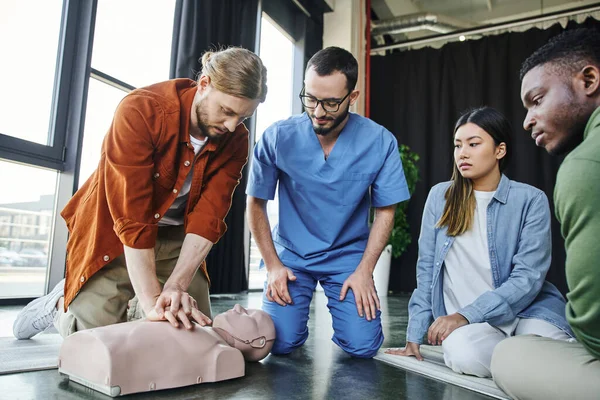Saving Lives: The Ultimate Guide To Healthcare Emergency Response Training
In the ever-evolving landscape of healthcare, emergency situations are an inevitable reality. Whether it's a sudden cardiac arrest, a severe injury, or a natural disaster, healthcare professionals need to be equipped with the knowledge and skills to respond swiftly and effectively. This is where emergency response training becomes paramount. In this comprehensive guide, we'll delve into the importance of healthcare emergency response training, the key elements it encompasses, and how individuals and institutions like OnAlert can ensure they're adequately prepared to save lives.
Understanding the Importance of Emergency Response Training
The Critical Role of Healthcare Professionals
Healthcare professionals are the frontline responders in times of crisis, tasked with the crucial mission of preserving life and promoting well-being. Their expertise, compassion, and quick thinking are paramount in delivering timely and effective care to those in need. From administering life-saving interventions to providing comfort and support, healthcare professionals play an indispensable role in every aspect of emergency response, embodying the unwavering commitment to saving lives that defines the essence of their profession.
Rapid Intervention Saves Lives
In the realm of emergency medicine, every moment counts. Rapid intervention is the linchpin of life-saving efforts, where swift and decisive action can mean the difference between life and death. From administering CPR to controlling bleeding and stabilizing patients in critical condition, the urgency of response is paramount. In these critical moments, healthcare professionals serve as the vanguards of hope, their quick thinking and skilled hands paving the way for survival and recovery.

Key Elements of Healthcare Emergency Response Training
Basic Life Support (BLS)
At the core of emergency response training is Basic Life Support (BLS). BLS encompasses fundamental lifesaving techniques such as cardiopulmonary resuscitation (CPR), airway management, and the use of automated external defibrillators (AEDs). Healthcare professionals undergo rigorous training to master these skills, enabling them to intervene effectively in cardiac arrest and other life-threatening scenarios.
Advanced Life Support (ALS)
For more complex emergencies, Advanced Life Support (ALS) training is essential. ALS builds upon the foundation of BLS and covers advanced interventions such as advanced airway management, intravenous (IV) access, and medication administration. Healthcare providers who undergo ALS training are equipped to manage critical patients in a variety of settings, including emergency departments, intensive care units, and pre-hospital environments.
Trauma Care
Traumatic injuries require specialized care, and healthcare providers must be prepared to deliver timely and effective treatment. Trauma care training focuses on techniques such as hemorrhage control, splinting, and rapid assessment protocols like the Advanced Trauma Life Support (ATLS) guidelines. By honing these skills, healthcare professionals can optimize outcomes for patients with traumatic injuries, whether they occur in the field or within healthcare facilities.

Ensuring Adequate Training and Preparedness
- Continuous education: Continuous education is the lifeblood of healthcare, keeping professionals abreast of the latest advancements and best practices. Through ongoing learning, practitioners refine their skills, stay current with evolving standards, and ultimately deliver higher quality care to those they serve.
- Standardized protocols: Standardized protocols serve as guiding principles in healthcare, ensuring uniformity and consistency in treatment approaches. By adhering to established guidelines, healthcare providers can optimize patient outcomes and minimize variability in care delivery.
- Interdisciplinary collaboration: Interdisciplinary collaboration harnesses the collective expertise of diverse healthcare professionals, fostering a holistic approach to patient care. By integrating insights from multiple disciplines, teams can address complex medical challenges more effectively and improve patient outcomes.
- Regular drills and exercises: Regular drills and exercises are essential for maintaining readiness and honing emergency response skills. Through simulated scenarios, healthcare professionals can practice decision-making and teamwork in a controlled environment, ensuring preparedness when real-life emergencies arise.
Specialized Training Programs
Pediatric Emergency Care
Children have unique medical needs, and healthcare professionals must receive specialized training to effectively manage pediatric emergencies. Pediatric emergency care training covers topics such as pediatric advanced life support (PALS), neonatal resuscitation, and recognition of child abuse and neglect. By understanding the physiological differences and developmental considerations in pediatric patients, healthcare providers can deliver age-appropriate care that maximizes outcomes for children in distress.
Geriatric Emergency Medicine
As the population ages, healthcare providers are increasingly called upon to care for elderly patients in emergency settings. Geriatric emergency medicine training focuses on the unique challenges and complexities of treating older adults, including geriatric syndromes, polypharmacy, and end-of-life care considerations. By incorporating principles of geriatric assessment and management into their practice, healthcare professionals can improve outcomes and enhance the quality of care for elderly patients experiencing acute medical crises.
Technology and Innovation in Emergency Response Training
Simulation-Based Training
Simulation-based training provides a safe and controlled environment for healthcare professionals to practice their emergency response skills. High-fidelity simulators replicate realistic clinical scenarios, allowing participants to apply their knowledge and decision-making skills in a hands-on setting. Simulation-based training enhances retention, improves teamwork, and identifies areas for improvement in a low-risk environment, ultimately enhancing preparedness and confidence in managing real-life emergencies.
Virtual Reality (VR) and Augmented Reality (AR)
Virtual reality (VR) and augmented reality (AR) technologies offer innovative solutions for immersive emergency response training. VR simulations can transport healthcare providers into realistic virtual environments, where they can interact with lifelike scenarios and practice critical skills in a highly engaging manner. AR applications overlay digital information onto the real world, enabling practitioners to visualize anatomical structures, medical devices, and procedural steps in real-time, enhancing learning and performance in emergency settings.

